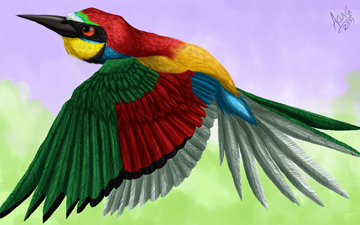The European Bee-eater (Merops apiaster), is a near passerine bird in the bee-eater family Meropidae. It breeds in southern Europe and in parts of north Africa and western Asia. It is strongly migratory, wintering in tropical Africa, India and Sri Lanka. This species occurs as a spring overshoot north of its range, with occasional breeding in northwest Europe.
This species, like other bee-eaters, is a richly-coloured, slender bird. It has brown and yellow upper parts, whilst the wings are green and the beak is black. It can reach a length of 27–29 cm (10.6–11.4 in), including the two elongated central tail feathers. Sexes are alike.
This is a bird which breeds in open country in warmer climates. Just as the name suggests, bee-eaters predominantly eat insects, especially bees, wasps and hornets which are caught in the air by sorties from an open perch. Before eating its meal, a European Bee-eater removes the sting by repeatedly hitting the insect on a hard surface. It eats some 250 bees daily. Lizards and frogs are also taken.
These bee-eaters are gregarious, nesting colonially in sandy banks, preferably near river shores, usually at the beginning of May. They make a relatively long tunnel in which the 5 to 8, spherical white eggs are laid around the beginning of June. Both the male and the female take care of the eggs, which are brooded for about 3 weeks. These birds also feed and roost communally.
The call is a pleasant distinctive trill.
(From Wikipedia, 1 July 2012)
—
European bee-eaters are mid-sized insectivores that have dark, thick, and slightly downward curved bills. A bright yellow chin and throat patch meet a blue chest that extends down to the flanks and belly. Dark lores and eye-stripe are contrasted by a white patch above the upper mandible and lower white eye-stripe extending from the lower mandible. A dark chestnut color covers the crown and nape, becoming lighter in color on the back. Upper tail coverts are variable, ranging from green to blue, with most of the tail being blue. Wing lengths average 44 cm for males and 49 cm for females. Weights of European bee-eaters are similar in males and females and range from 44 to 78 g. Total body length ranges from 27 to 30 cm.
Males and females, very similar in coloration, can be distinguished by the hue of the greater coverts, being a chestnut in males and greenish-blue in females, and by the median coverts, where males are a chestnut and females have a greenish hue. Juveniles can be distinguished from adults by the color of the iris. In mature adults the iris is a vibrant red and juveniles will have a grayish-olive-red color. Also, the chestnut color found in adults is only green in juveniles.
European bee-eaters are commonly found near freshwater systems and inhabit a variety of habitat types such as forest, savanna, shrubland, grassland, and agricultural areas. The habitat for nesting can be specific involving only river systems or gravel pits with steep exposed banks. European bee-eaters have also been found to dig burrows directly into the ground. Food availability can determine the habitat occupied by European bee-eaters. Many agricultural fields use bee-hives for pollination and M. apiaster will frequent those areas.
(From EOL, 1 July 2012)





